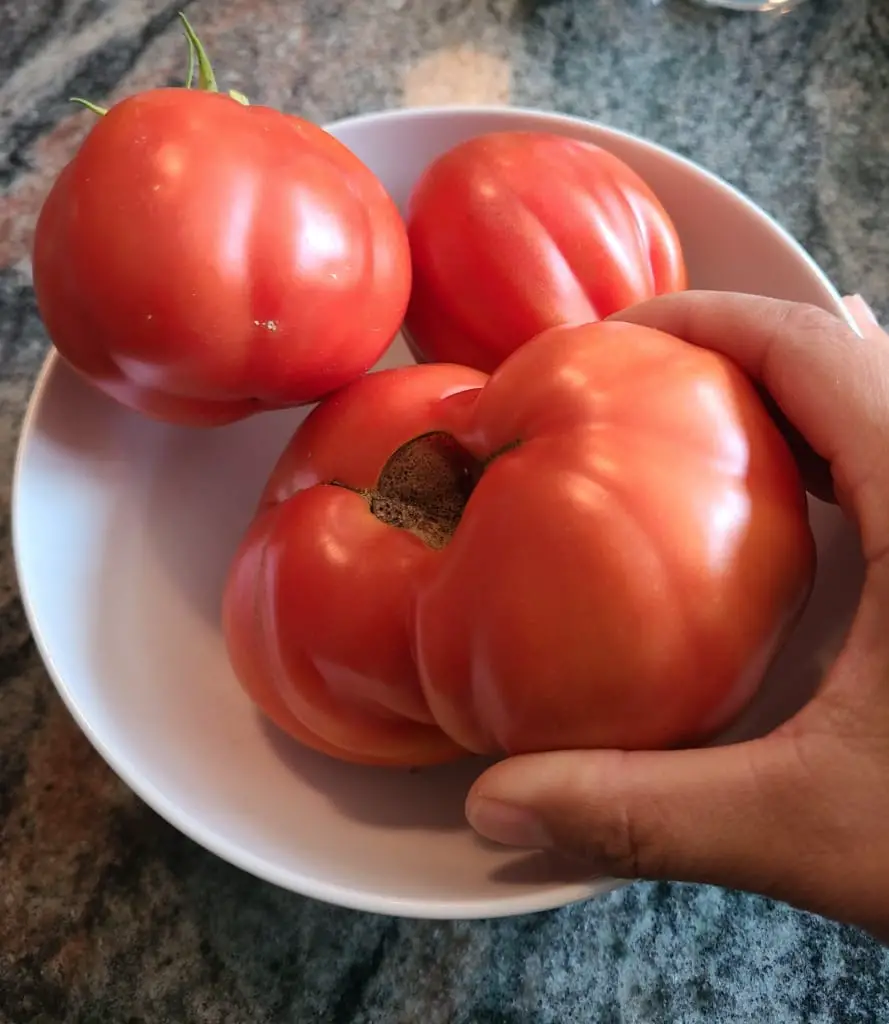What is Bruschetta? Welcome to the world of bruschetta, an Italian appetizer that will transport your taste buds to the picturesque Italian countryside with every bite. This quintessential dish, known for its simple ingredients and versatile nature, has captivated both chefs and home cooks alike with the myriad of bruschetta recipes available today.
At the heart of this culinary sensation lies the perfect combination of toasted bread, fresh tomatoes, and aromatic basil, embellished with a sumptuous drizzle of extra virgin olive oil. It’s a celebration of the finest ingredients and a testament to the charm of Italian cuisine.
Curious about how this dish came to be? Keep reading to discover more about the exciting world of bruschetta and its many delicious forms.
What is Bruschetta?
Bruschetta is a classic Italian appetizer that showcases the simplicity and flavors of fresh, quality ingredients. It typically consists of grilled bread rubbed with garlic and topped with a mix of chopped tomatoes, fresh basil, olive oil, and salt. Variations may include ingredients like mozzarella, balsamic vinegar, or chopped vegetables.
This Italian antipasto is celebrated for its crisp texture, vibrant colors, and the delightful contrast between the warm, toasted bread and the cool, fresh topping. It’s a popular dish served in restaurants and homes for its easy preparation and versatile nature, making it a perfect start to a variety of meals.

The Historical Crumbs: Bruschetta Through the Ages
Originating from the Italian word “bruscare,” which means “to roast over coals,” bruschetta owes its popularity to its rustic origins and the resourceful farmers who crafted it from the most basic ingredients.
Bruschetta’s inception can be traced back to ancient Rome, where farmers and laborers turned stale bread into a delicious feast. By grilling bread over hot coals and infusing it with the flavors of garlic and olive oil, they created a satisfying and simple dish that represents the essence of Italian cuisine. This resourcefulness epitomizes the spirit of bruschetta and continues to guide its contemporary reinterpretations.
Over the centuries, bruschetta has evolved from its humble beginnings as a rustic peasant dish to a gourmet delight, adorning the menus of boutique bistros and fine dining establishments alike. As bruschetta gained recognition, the versatile appetizer was continuously reimagined and adapted while staying true to its core elements of high-quality, fresh ingredients.
Today, this celebration of simplicity stands as a testament to the enduring appeal of Italian cuisine, with its historical roots and rustic origins making the perfect toast to gastronomic history.
Choosing the Perfect Bread for Bruschetta
The journey to creating the quintessential bruschetta begins with selecting the right bread. A well-executed crusty Italian loaf with a crisp exterior and a pillowy-soft interior is the foundation for the perfect bruschetta experience.
Traditionalists opt for a rustic Italian loaf like ciabatta or pane toscano, emphasizing the importance of a crusty exterior and soft interior. The ideal thickness allows the bread to achieve a golden toasty perfection while maintaining a tender crumb, acting as the perfect canvas for carrying the delectable toppings.
Different Breads Used in Bruschetta Around the World
Bruschetta is a versatile dish that can be made with various types of bread, depending on what’s available locally or preferred regionally. In Italy, the classic choice is ciabatta, which is known for its crispy crust and porous texture, soaking up the olive oil beautifully.
Outside of Italy, people often use baguettes in France or sourdough in the United States, both of which provide a sturdy base that holds up well under the weight of juicy tomatoes and other toppings.
In Spain, you might find bruschetta-like tapas served on slices of rustic bread, while in Greece, a thicker, heartier loaf might be used to accommodate additional toppings like feta or olives. Each type of bread brings its unique flavor and texture to bruschetta, making it a truly global delight that adapts to local tastes and ingredients.
Related Article: If you’re looking to enhance your bruschetta experience with a unique twist, consider serving it on Italian garlic bread with a red wine base or grilled polenta. Both options offer distinct flavors, making each bite of your bruschetta uniquely delicious.
Exploring the Essential Toppings for Bruschetta
At the very heart of bruschetta lies its topping, which artfully combines a symphony of fresh ingredients, balancing flavors and textures to create a delicious Italian antipasto. Let’s explore the key ingredients that make traditional bruschetta an unforgettable culinary experience.
Tomatoes
It is no secret that tomatoes are the true star of bruschetta toppings. Their juicy sweetness and acidity make them the ideal companion for crusty bread. For an authentic bruschetta experience, traditional recipes favor Roma or San Marzano tomatoes, which strike an optimum balance of flavor and texture.
Dice the tomatoes and season them with salt, pepper, and fresh herbs to bring out their natural vibrancy and make your bruschetta truly shine.
Olive Oil
Often referred to as the ‘lifeblood’ of Italian cooking, extra virgin olive is crucial for bringing all the flavors of bruschetta together. It graces the toasted bread with a richness and smooth mouthfeel that balances the acidity of the tomatoes.
Fresh Basil
No bruschetta is complete without fresh basil. This herb adds a burst of freshness that contrasts beautifully with the rich tomatoes and robust garlic. Its aromatic leaves are often torn and sprinkled over the top, infusing each bite with its vibrant, peppery essence.
Garlic
Garlic is another non-negotiable in bruschetta. Typically, a clove is rubbed across the toasted bread before topping, lending a subtle sharpness that perks up the entire dish without overwhelming it.
The Art of Assembly: Crafting the Perfect Bruschetta Bite
Assembling bruschetta is an art that requires attention to detail, a fundamental understanding of the fresh preparation process, and adherence to the Italian method. The following steps will guide you through crafting a genuine bruschetta experience:
- Toast the bread: Begin by toasting the sliced bread to a crisp but still pleasantly palatable texture, ensuring the right balance between crunchiness and softness.
- Infuse with garlic: Once the bread is toasted, rub a fresh garlic clove on its surface to impart a subtle hint of pungent spiciness.
- Drizzle with olive oil: Generously drizzle extra virgin olive oil over the toasted bread, enriching the flavor base and preparing the foundation for the tomato topping.
- Add the tomato blend: Spoon a freshly prepared blend of diced tomatoes onto the bread. Opt for ripe tomatoes seasoned with just the right amount of salt and pepper to ensure a harmonious marriage of flavors.
- Finish with basil: Complete your bruschetta masterpiece by adorning it with torn basil leaves, adding a touch of freshness to each bite.
While mastering the art of bruschetta, consider pairing it with another Italian classic that showcases the depth of Italian cooking—sausage risotto. This creamy, comforting dish complements the crisp, fresh flavors of bruschetta, making for a full-flavored Italian meal that’s both satisfying and delightful.
Health Benefits of Bruschetta: More Than Just a Tasty Snack
While bruschetta delights the palate, it also provides health benefits owing to the antioxidants and nutrients found in tomatoes and olive oil. Rich in vitamins A, C, and K, tomatoes promote a healthy immune system, wound healing, and stronger bones, whereas the mono-unsaturated fats present in extra virgin olive oil are known to support a healthy heart and reduce inflammation.
You can make bruschetta even healthier by adding other veggies like bell peppers or spinach, which add more nutrients and flavors. With its vibrant flavor composition and remarkable versatility, bruschetta proves itself to be an enduring favorite in the world of Italian appetizers.
Whether served at a casual gathering or a fancy dinner, bruschetta remains a favorite for its health benefits and its ability to bring people together around good food.
Global Twists: Bruschetta Reimagined Beyond Italy
As the world embraces the culinary delights of bruschetta, international adaptations have emerged to reflect the diverse tastes of global cuisine. From Mediterranean infusions to adventurous fusion inspirations, the versatility and simplicity of this classic Italian appetizer continue to inspire a myriad of creative bruschetta recipes.

Mediterranean Infusions
By incorporating the unique flavors of neighboring Mediterranean regions, bruschetta goes beyond the borders of Italy to create delectable combinations that showcase the rich culinary traditions of the area. Introducing ingredients such as olives, feta, and aromatic herbs adds complexity to the original dish while staying true to the essence of bruschetta’s fresh, high-quality components.
Adventurous Fusion Inspirations
Inspired by the innovative spirit of global cuisine, chefs and food-lovers alike experiment with unconventional toppings to create an entirely new bruschetta experience. Avocado, smoked salmon, and artisanal cheeses are just a few examples of how the humble Italian starter continues to evolve while still maintaining its core values of simplicity and quality.
Sweet Twists
Beyond the realm of savory, bruschetta has also ventured into the world of sweets. Some versions now feature sweet toppings like fresh fruit or spreads like Nutella, merging Italian tradition with modern, adventurous tastes. This sweet take on bruschetta offers a delightful surprise that continues to charm food lovers everywhere.
Conclusion
Bruschetta is much more than just a tomato-topped toast. It’s a testament to the power of simplicity in cooking, showcasing how a few quality ingredients can create a universally loved dish. As bruschetta continues to evolve with global influences, it embraces new flavors and ingredients, making it a favorite among those who appreciate both tradition and innovation.
Whether you prefer the classic version or one of the adventurous new twists, bruschetta remains a delightful part of the culinary world, proving that good food brings people together, no matter where they are from. So next time you’re looking for a tasty and versatile dish, why not try making bruschetta at home? It’s sure to be a hit!
FAQ
Is bruschetta served hot or cold?
The bread in bruschetta is typically served warm or toasted, but the tomato topping is usually cool, making the dish a combination of warm and cool elements.
What are some common variations of bruschetta?
Popular variations include adding chopped olives, feta cheese, or different herbs. Some adventurous versions even include toppings like avocado or smoked salmon.
Is bruschetta vegan?
Traditional bruschetta with just tomatoes, garlic, olive oil, and basil is vegan. However, variations that include cheese or other animal products are not.
Can bruschetta be considered a healthy dish?
Yes, bruschetta can be quite healthy. It includes fresh tomatoes, which are high in vitamins and antioxidants, and olive oil, which is a good source of heart-healthy monounsaturated fats.
How has bruschetta’s popularity influenced restaurant menus and home cooking?
Bruschetta’s simplicity and versatility have made it an appealing starter on menus ranging from casual bistros to upscale restaurants. It also serves as a versatile element in home cooking for casual family meals, elegant dinner parties, or as a nutritious snack, allowing for customization and adaptation to suit any occasion.





